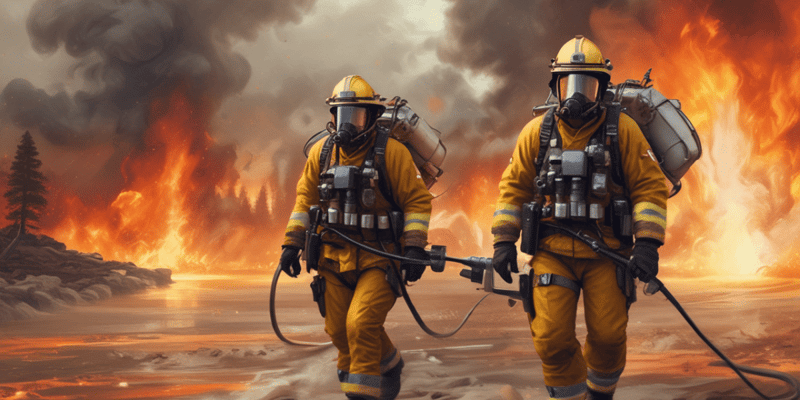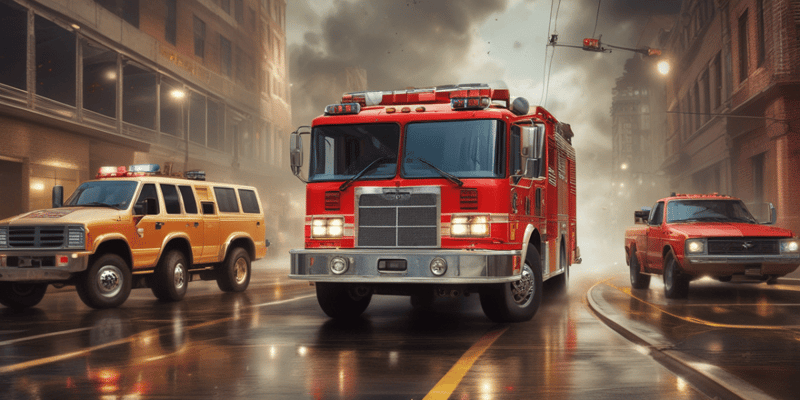38 Questions
What is the primary goal of operating positions in a defensive strategy?
To position as far from the involved area as possible while remaining effective
Why should personnel be restricted from wandering about the fireground?
To minimize fireground confusion and congestion
What is the purpose of limiting the number of personnel on the fireground?
To minimize the risk of injury to personnel
Why is communication critical between opposing crews?
To manage conflicting operations and prevent injuries
What is the minimum number of personnel required to work in the Hot Zone?
Two
What defines the Hot Zone?
Any area that requires an SCBA, charged hoseline, special protective clothing, or in which firefighting personnel are at risk of becoming lost, trapped, or injured by the environment or structure
Why should caution be used when applying exterior hand line water into a compartment?
To prevent structural collapse and protect interior crews
What function would typically be done inside the Warm Zone?
Laying lines
What is the purpose of sectorization on the fireground?
To maintain accountability and control of forces
When laddering buildings under fire conditions, where should ladders be placed?
Near building corners or fire walls
What is the primary focus of an offensive strategy in firefighting?
To eliminate most eventual safety problems through a coordinated interior attack
What is the primary concern in the Cold Zone?
Unforeseen violence
Who is responsible for ensuring all crew members are operating within their assigned sector?
Company Officer
What is a critical aspect of operating in the Hot Zone?
Both a and b
What is the primary purpose of the Fireground Safety policy?
To establish general safety guidelines for operating personnel
What is a critical factor in affecting the safety and survival of operating companies?
The positioning of operating companies
What is a key consideration for Command when making an offensive/defensive decision?
The safety of firefighting personnel
What is an example of a hazardous situation that firefighters should be aware of?
Operating above the fire
What is a common indication of potential structural failure in a fire-affected building?
Flexible movement of any floor or roof where firefighters walk
Which of the following construction features is a potential contributor to early structural failure?
Parapet walls
What should be done when fire conditions are heavy and structural failure appears likely?
Initiate a careful evaluation of structural conditions and prepare to withdraw interior crews
When should the 'Emergency Traffic' announcement be used?
When a hazard is imminent or has just occurred
Why is it essential to continually evaluate structural conditions during a fire?
To identify potential hazards and prevent collapse
What should happen when interior firefighting operations become untenable due to the extent of the fire or structural conditions?
Evacuate, account for personnel, regroup, and redeploy
What is a primary concern during a fire involving a building with known structural hazards?
The welfare of firefighting personnel
Why is it important to have a structured method of area evacuation during a fire?
To provide for the rapid and effective notification of personnel and accurate accounting
Who is responsible for recognizing situations involving a high risk to personnel and initiating appropriate safety measures?
Command
What is the primary responsibility of all officers in terms of safety?
Ensuring the safety of their assigned personnel
What should be considered in the development of any incident action plan?
Structural collapse
What is the most likely candidate for failure in a fire-involved building?
Roof
What is a sign of building collapse?
Cracks in exterior walls
Who usually initiates the emergency traffic process?
A Company Officer
What should Company Officers do upon receipt of the emergency traffic evacuation order?
Assemble their crews and promptly exit to a safe location
What is the primary goal of search and rescue operations?
To locate possible victims
What should be done before entering the search area?
Develop a search plan and communicate it to the team
How should individual search activities be conducted whenever possible?
By two or more members
What should be done when conducting a search above the fire floor?
The search team should be protected with a charged hose line
What should be done after all affected crews and crew members are accounted for?
A more specific determination of the hazard can be made
Study Notes
Fireground Safety Policy
- The purpose of this policy is to establish general safety guidelines for operating personnel.
- The safety of firefighting personnel represents the major reason for an effective and well-timed offensive/defensive decision.
Tactical Positioning
- Positioning of operating companies can severely affect the safety/survival of such companies.
- Personnel must use caution when placed in the following positions: • In the direct flow path of the fire • Working into wind-driven conditions • Above the fire (floors/roof) • Where fire can move in behind or above them • Where position and retreat cannot be controlled • When involved with opposing fire streams • Combining interior and exterior attack • With limited access--one way in/out • Operating under involved roof structures • In areas containing hazardous materials • Below ground fires (basements, etc.) • In areas where a flashover or backdraft potential exists • Above/below ground rescue
Standard Risk Management Plan
- WE MAY RISK OUR LIVES A LOT, IN A CALCULATED MANNER, TO PROTECT SAVABLE LIVES
- WE MAY RISK OUR LIVES A LITTLE, IN A CALCULATED MANNER, TO PROTECT SAVABLE PROPERTY
- WE WILL NOT RISK OUR LIVES AT ALL FOR LIVES OR PROPERTY THAT IS ALREADY LOST
Defensive Strategy
- When operating in a defensive strategy, operating positions should be as far from the involved area as possible while still remaining effective.
- Position and operate from behind barriers if available (fences, walls, etc.).
Offensive Strategy
- An effective, coordinated interior attack operation directed toward knocking down the fire eliminates most eventual safety problems.
- The operational focus should be to get water on the fire from the most effective position available.
Fireground Operations
- Efforts must be made by Command to limit the number of personnel on the fireground to those assigned to a necessary function.
- Individuals or crews shall be restricted from wandering about the fireground or congregating in non-functional groups.
Hot Zone
- The Hot Zone is defined as any area that requires an SCBA, charged hoseline, special protective clothing, or in which firefighting personnel are at risk of becoming lost, trapped, or injured by the environment or structure.
- All firefighters working in the Hot Zone shall be in crews of a minimum of two personnel, wearing appropriate PPE, with a radio on the correct tactical channel, and must have an assigned task or function.
Warm Zone
- The Warm Zone is defined as the area just outside of the Hot Zone where the firefighters start their operations on the fireground.
- This zone is where the firefighter is not at risk of becoming lost, trapped, or injured by the environment or structure.
Cold Zone
- The Cold Zone is defined as outside of the Warm Zone where no one is at risk because of the incident.
- All operating personnel must remain vigilant on emergency incidents.
No-Entry Zone
- The No-Entry Zone is defined as the area at an incident that no person shall be permitted to enter due to an imminent hazard, dangerous condition, or the need to protect evidence.
- Operating personnel need to be informed of the No-Entry Zone.
Sectors
- The safety of firefighting personnel represents a major reason for fireground sectorization.
- Sector Officers must maintain the capability to communicate with forces under their command.
Structural Collapse
- Structural collapse has been a major cause of serious injury and death to firefighters.
- The possibility of structural collapse should be a major consideration in the development of any incident action plan.
- Signs of building collapse may include: • Cracks in exterior walls • Bulges in exterior walls • Sounds of structural movement--creaking, groaning, snapping, etc. • Smoke or water leaking through walls • Water accumulation on a roof • Windows, doors, floors, and stairs out of level • Flexible movement of any floor or roof where firefighters walk • Interior or exterior bearing walls or columns--leaning, twisting, or flexing • Sagging or otherwise distorted rooflines • Time of fire involvement
Evacuation of Firefighting Personnel
- Interior firefighting operations should be abandoned when the extent of the fire prohibits control, or the structure becomes unsafe to operate within.
- When such conditions make the building untenable, evacuate, account for personnel, regroup, recommunicate, and redeploy.
Search and Rescue
-
Search and rescue should be performed according to an efficient, well-planned procedure which includes the safety of search crew personnel.
-
The object of the search effort is to locate possible victims, not create additional ones by neglecting the safety of the search crew.
-
Fire victims are typically killed through thermal and/or toxic exposure.
-
Prior to entering the search area, all search team members should be familiar with a specific search plan including the overall objective, a designation of the search area, individual assignments, etc.### Search and Rescue Operations
-
Before entering the search area, crew members may need to confer to develop and communicate a plan.
-
Individual search activities should be conducted by two or more members whenever possible.
-
In residential search and rescue operations, firefighters may search off the hoseline.
-
Company Officers must maintain awareness of the position and function of all crew members during search operations.
Fireground Safety
- In non-residential fire operations, firefighters should not operate off of the hoseline.
- A brief look around the floor below the fire can provide a good reference for the search team, as floors in multi-story occupancies usually have a similar layout.
- When conducting a search that exposes search crews to fire conditions (especially above the fire floor), the search team should be protected with a charged hose line.
Establish general safety guidelines for firefighting personnel, including tactical positioning and decision-making to ensure safety and survival.
Make Your Own Quizzes and Flashcards
Convert your notes into interactive study material.
Get started for free



